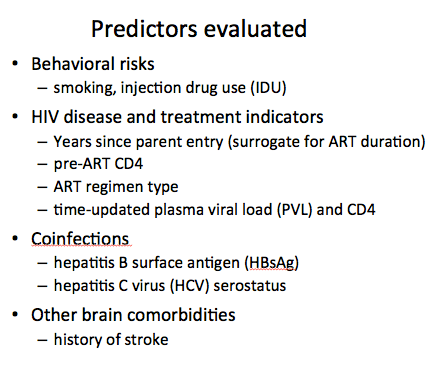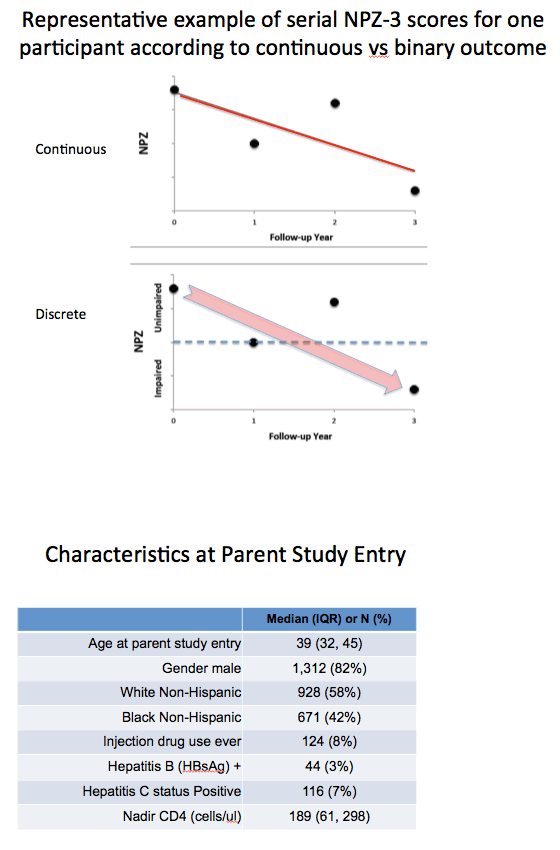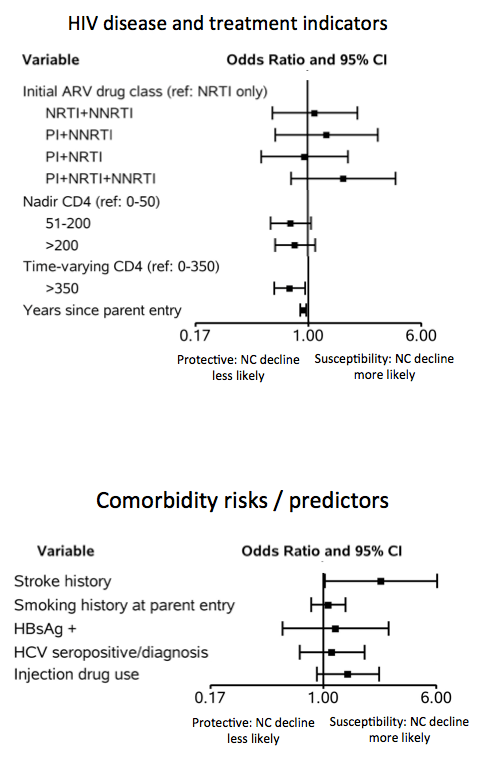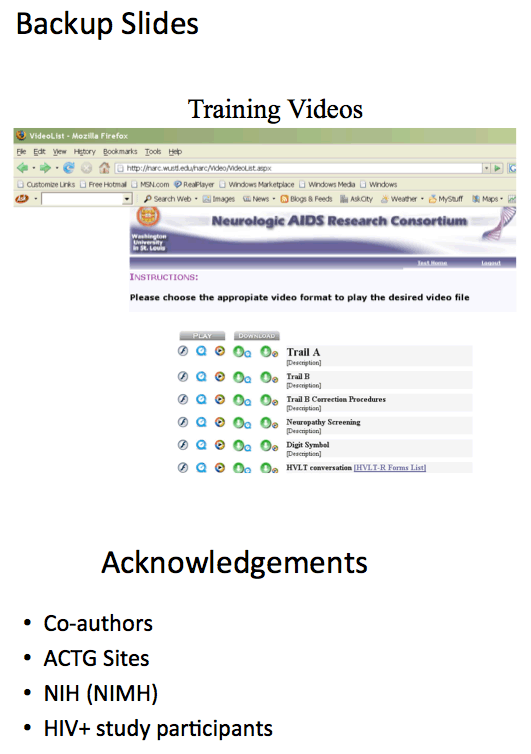 |
 |
 |
| |
Longer ART, Better CD4 Gain Protect From Neurocognitive Decline in ACTG Analysis
|
| |
| |
20th International AIDS Conference, July 20-25, 2014, Melbourne
Mark Mascolini
Longer antiretroviral therapy (ART) duration and a bigger CD4-cell gain protected against neurocognitive decline in a large prospective AIDS Clinical Trials Group (ACTG) cohort [1]. A history of stroke boosted the risk of declining neurocognitive performance in the ACTG Longitudinal Linked Randomized Trials (ALLRT).
HIV-associated neurocognitive disorder (HAND) persists in the current antiretroviral era [2,3], though usually in asymptomatic or mild forms. Understanding predictors of neurocognitive impairment is gaining urgency as people live longer while taking antiretrovirals and run a higher risk of neurocognitive problems with older age.
ALLRT is a prospective observational cohort whose participants have repeat neuropsychological testing. All were naive to antiretrovirals until they entered one of ALLRT's six parent ACTG trials. Neuropsychological testing consisted of Trailmaking Tests A and B and the WAIS-R Digit Symbol subtest. The investigators summarized overall performance in a z-score across the three tests (NPZ-3). They defined impairment as a score 1 standard deviation or more below the normal mean on at least two tests or 2 or more standard deviations below the mean on one test.
The analysis involved 1599 antiretroviral-treated people, 58% of them non-Hispanic white and 42% African American. Most cohort members, 82%, were men. Upon entering the parent study, median age measured 39 years and median years of education 14. Only 8% of participants reported previous or current injection drug use; 1% had a history of stroke; 3% tested positive for HBV and 7% for HCV. Median pre-ART CD4 count stood at 189 (interquartile range 61 to 298), and 35% of participants had a pretreatment viral load above 100,000 copies. About 95% of the study group achieved durable virologic suppression.
Multivariable repeated measures regression analysis identified three independent predictors of NPZ-3 worsening during follow-up ranging from 2 to 9 years (median 6): More years since entering the parent study (and thus more years on ART) and a time-varying CD4 count above 350 (versus below) protected against neurocognitive decline. Compared with a nadir CD4 count below 51, a nadir of 51 to 200 or above 200 tended to protect against decline, but those associations fell short of statistical significance. Among comorbidity risk factors, only a history of stroke independently raised the odds of declining NPZ-3 score. In a nonsignificant association, injection drug use tended to boost odds of worsening neurocognitive function.
Analyzed factors that did not independently predict a falling NPZ-3 were older age, virologic suppression (below 200 copies) on ART, CD4 nadir, antiretroviral class, smoking history when entering the parent study, injection drug use history, and positivity for HBV and HCV.
The ALLRT investigators noted that their analysis is limited by lack of pre-ART neurocognitive assessment and by inability to rigorously assess neuropsychiatric comorbidities such as substance abuse and depression. With those caveats in mind, they concluded that longer ART duration and continuing CD4 recovery are linked to protection against declining neurocognitive function. Stroke conferred an increased risk, and the researchers noted that vascular risk factors are highly prevalent in an aging HIV population.
A smaller longitudinal analysis of neurocognitive decline predictors presented at AIDS 2014 (reported separately by NATAP) focused on a group with somewhat different HIV-related characteristics and used a different neuropsychological testing scheme and outcome [4]. That CHARTER cohort analysis determined that being off ART, poor general health, and neuropsychiatric comorbidities predicted earlier neurocognitive decline.
References
1. Smurzynski M, Yang M, Robertson K, et al. Predictors of impaired neurocognitive performance during follow-up among ART-naive individuals initiating ART in ACTG clinical trials. AIDS 2014. 20th International AIDS Conference. July 20-25, 2014. Melbourne. Abstract THAB0106.
2. Chan P, Brew BJ. HIV associated neurocognitive disorders in the modern antiviral treatment era: prevalence, characteristics, biomarkers, and effects of treatment. Curr HIV/AIDS Rep. 2014 Jun 27. Epub ahead of print.
3. Heaton RK, Clifford DB, Franklin DR Jr, et al. HIV-associated neurocognitive disorders persist in the era of potent antiretroviral therapy: CHARTER Study. Neurology. 2010;75:2087-2096.
4. Heaton R, Franklin D, Deutsch R, et al. Neurocognitive change in the era of HIV combination antiretroviral therapy: a longitudinal CHARTER study. AIDS 2014. 20th International AIDS Conference. July 20-25, 2014. Melbourne. Abstract THAB0103.
--------------------------


So in summary,
This work goes beyond prior cross-sectional and short-term longitudinal findings
In this large cohort of ART-naïve participants followed while remaining on their first ARV regimen, ~95% of whom achieved durable virologic suppression, longer duration of treatment was linked to protection from neurocognitive decline.
Continuing CD4 recovery was linked to protection as well - and I think this is consistent with previous cross-sectional studies showing that higher CD4 nadir correlates with protection from impairment and also better CD4 recovery
In addition, specific comorbid conditions confer increased risk of poorer outcomes - particularly stroke
Strengths: Large, diverse cohort;
Limitations: No pre-ART assessment, neuropsychiatric comorbidities (substance abuse, depression) not rigorously assessed








|
| |
|
 |
 |
|
|